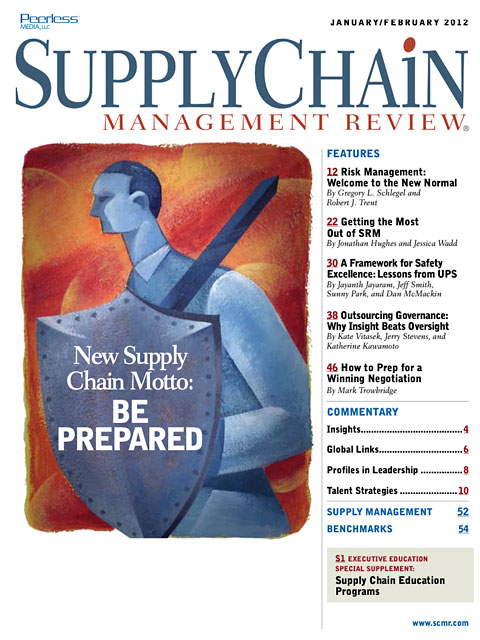Sorry, but your login has failed. Please recheck your login information and resubmit. If your subscription has expired, renew here.
January-February 2012
The potential risk of supply chain disruption has never been greater. In fact, it’s become the new normal, say authors and educators Robert Trent and Greg Schlegel. The problem for many companies is that they are ill prepared to handle a disruption should one occur. This article argues for a new set of risk management techniques in a world where heightened supply chain risk has become a fact of business life. Browse this issue archive.Need Help? Contact customer service 847-559-7581 More options
Only a few years ago, supplier relationship management (SRM) was generally thought of as a software tool. That’s not surprising as SAP, Oracle, Ariba, and others have offered multiple products that bear the label “SRM.” But true SRM entails much more than purchasing new software. Done right, it’s a systematic approach to supply chain collaboration that enhances the business performance of both customers and supplier. But just as customer relationship management (CRM) has proven to be far more about creating a customer-centric culture, transforming business practices, and building new mindsets and skills than simply an IT solution, successfully implementing SRM requires more than the purchase of new software.
In a sense, SRM is picking up where strategic sourcing left off. Despite the significant savings many companies have realized through strategic sourcing over the past two decades, the limitations of this discipline have become increasingly apparent. In a 2008-09 global research study we conducted involving more than 500 companies, buy-side respondents reported that nearly half (46 percent) of potential value from supplier contracts isn’t realized during implementation.1 Perhaps even more surprisingly, sell-side respondents reported delivering only 66 percent of potential contract value.
These sobering statistics point to a key driver behind the development and evolution of SRM as a formal supply chain management discipline. Strategic sourcing, in practice, has led to an enormous focus on interactions with suppliers up to the point of signing new contracts. Yet it has provided relatively little guidance on how to effectively manage the complex and critical interactions between customers and suppliers as they work together to execute against agreements.
 |
This complete article is available to subscribers
only. Click on Log In Now at the top of this article for full access. Or, Start your PLUS+ subscription for instant access. |
Not ready to subscribe, but need this article?
Buy the complete article now. Only $20.00. Instant PDF Download.
Access the complete issue of Supply Chain Management Review magazine featuring
this article including every word, chart and table exactly as it appeared in the magazine.
SC
MR
Sorry, but your login has failed. Please recheck your login information and resubmit. If your subscription has expired, renew here.
January-February 2012
The potential risk of supply chain disruption has never been greater. In fact, it’s become the new normal, say authors and educators Robert Trent and Greg Schlegel. The problem for many companies is that they are… Browse this issue archive. Download a PDF file of the January-February 2012 issue. |
Download Article PDF |
Only a few years ago, supplier relationship management (SRM) was generally thought of as a software tool. That’s not surprising as SAP, Oracle, Ariba, and others have offered multiple products that bear the label “SRM.” But true SRM entails much more than purchasing new software. Done right, it’s a systematic approach to supply chain collaboration that enhances the business performance of both customers and supplier. But just as customer relationship management (CRM) has proven to be far more about creating a customer-centric culture, transforming business practices, and building new mindsets and skills than simply an IT solution, successfully implementing SRM requires more than the purchase of new software.
In a sense, SRM is picking up where strategic sourcing left off. Despite the significant savings many companies have realized through strategic sourcing over the past two decades, the limitations of this discipline have become increasingly apparent. In a 2008-09 global research study we conducted involving more than 500 companies, buy-side respondents reported that nearly half (46 percent) of potential value from supplier contracts isn’t realized during implementation.1 Perhaps even more surprisingly, sell-side respondents reported delivering only 66 percent of potential contract value.
These sobering statistics point to a key driver behind the development and evolution of SRM as a formal supply chain management discipline. Strategic sourcing, in practice, has led to an enormous focus on interactions with suppliers up to the point of signing new contracts. Yet it has provided relatively little guidance on how to effectively manage the complex and critical interactions between customers and suppliers as they work together to execute against agreements.
 |
SUBSCRIBERS: Click here to download PDF of the full article. |
SC
MR

Latest Supply Chain News
Latest Podcast

 Explore
Explore
Latest Supply Chain News
- 2024 Warehouse/DC Operations Survey: Technology adoption on the rise
- Benchmarking the complexity of ESG reporting
- Looking back at NextGen 2024
- The Corporate Sustainability Due Diligence Directive
- How to make your CFO a supply chain superfan
- AI is moving omnichannel closer to the customer
- More latest news
Latest Resources

Subscribe

Supply Chain Management Review delivers the best industry content.

Editors’ Picks





